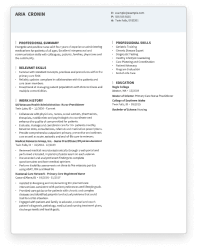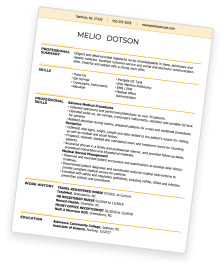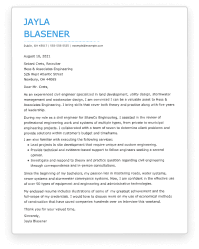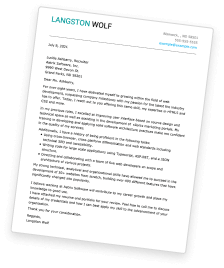Esthetician Resumes: Overview
As an esthetician, it is your job to help your clients obtain their full beauty based on your recommended skincare treatments.
Due to such responsibility, you may find yourself in various roles and environments, including:
- Spa Esthetician
- Medical Esthetician
- Freelance Esthetician
- Wellness Spa Esthetician
- Dermatology Clinic Esthetician
Regardless of where you end up, writing an effective resume showcasing your qualifications, such as client relations skills and knowledge of skincare best practices, is crucial to getting an esthetician position.
Thankfully, here at Hloom, we have just the kind of professional resume examples and downloadable templates to help you get started!
Esthetician Resume: Getting Started
Choosing the right resume format is pivotal in crafting an impactful esthetician resume, making sure how you present your skills and experience clearly communicates your qualifications and dedication to skincare. Let’s take a look at the three types of formats to get you going!
Chronological Resumes For Estheticians
The chronological format is the gold standard for most professionals, including estheticians.
By presenting your work history in reverse chronological order, employers gain a comprehensive view of your professional evolution.
Each work experience entry will detail your roles, responsibilities, and achievements to create a timeline reflecting your growth and understanding of skincare treatments.
Employers highly value work experience because it adds credibility to your skills, so you should consider using a chronological resume most of the time.
For example, a well-respected spa will not assume you understand the responsibilities of your esthetician position unless they see you have successfully accomplished similar responsibilities beforehand, either as an esthetician or in a related field.
Functional Resumes For Estheticians
With a functional resume, you showcase your esthetician knowledge and passion, even if your work history is brief, by emphasizing the skills and qualifications in specific sections that take up the majority of the page.
Although a functional resume can be a good choice for beginner estheticians and those with no experience, just remember that by minimizing your work history, you may not appear as a qualified candidate to employers.
Combination Resumes For Estheticians
Suppose you are an entry-level esthetician or are changing careers. In that case, you may want to consider the combination format, which blends the chronological and functional formats together, allowing you to spotlight your skills while detailing your relevant work experiences.
In this resume format, you devote an equal amount of space of the resume to skills and experience, providing specific examples of your past work responsibilities and achievements alongside more detail information about your most relevant skills.
As such, this hybrid approach can be perfect for estheticians with a mix of hands-on expertise and specialized skills, offering a comprehensive overview of your professional profile.
Choosing The Right Format
Picking the right resume format when applying to esthetician jobs depends of your needs, level of experience, and the type of position.
When in doubt, use the chronological format, which is the most ATS-friendly resume type. Applicant tracking systems (ATS) are based on the expectations of employers, which means if you do not put enough work experience in your document, you may be filtered out as a potential candidate before an actual person takes a look.
If you lack direct experience, do your best to make your past work or educational experience transferable, and consider using the combination format to bring your skills to the forefront.
A functional resume can also be used for beginner and entry-level estheticians. Still, only do this in cases when you know the employer will immediately look at your resume (so it doesn’t get filtered out by the ATS) and you are confident you can prove your abilities even with a lack of experience (such as having an online portfolio of work or through writing an excellent cover letter).
How To Write an Esthetician Resume
Knowing the outline of your resume is the first step to writing one. Here we will provide you with the steps you need to know so that you can write the best resume possible for your next esthetician job!
Contact Information
A resume is nothing without the proper contact information. How else are employers going to know who you are?
At the top of your resume, make sure to include your:
- Full name
- Phone number
- Professional email address
- Location (city/town and state)
If you have a LinkedIn profile or an online portfolio detailing your experience as an esthetician, you can also include them here as well. This can help evaluate your resume and highlight your passionate professionalism.
Summary or Objective
Introduce yourself with a captivating resume summary or objective clearly stating your most relevant qualifications. Your summary or objective should grab the reader’s attention and encourage them to learn more about your abilities as an esthetician.
A resume summary is ideal for estheticians with work experience, offering a brief overview of skills and achievements that strike at the most relevant qualities sought by the employer.
For example, a resume summary for an esthetician might look like:
“Results-driven esthetician with 5+ years of experience delivering premium skincare services. Proven expertise in rejuvenating treatments and a commitment to continuous learning in emerging skincare trends.”
However, if you are an entry-level esthetician with no experience, you could use an objective statement instead to express your skills and passion for the position clearly.
An objective statement for a beginner esthetician resume could look like:
“Aspiring esthetician with a passion for holistic skincare. Eager to leverage my comprehensive training in esthetics to provide exceptional skincare services and contribute to the beauty industry.”
In either case, use the summary or objective to highlight your best features as an esthetician professional to stand out from other candidates.
Work History
In most cases, the work history section of your resume will be the page’s main focus. Here is where you will detail your past esthetician positions and other related work experiences by providing your:
- Job title
- Employer
- Dates of employment
- Location
- Relevant responsibilities and accomplishments
List your work history in reverse chronological order, providing your most recent job title first, and use bullet points to explain your most relevant responsibilities and achievements.
Esthetician work comes with many different responsibilities, ranging from diagnosing skin conditions to monitoring treatment, so use the job description to determine which ones are best to focus on.
Here is an example of what a job entry might look like in the work history section of your esthetician resume:
Esthetician | Serenity Spa, Anytown, USA | May 2018 – Present
- Administered a variety of skincare treatments, including facials, chemical peels, and microdermabrasion.
- Customized skincare routines for clients based on individual needs and concerns.
- Maintained a loyal client base through exceptional service and personalized skincare advice.
If you list related work experiences, such as a customer service role, clearly establish how your skills and experience are transferable to the position you are applying for.
Skills
In a separate section, list your most relevant skills for the position, again using the esthetician job description to determine which are most relevant.
Esthetician work comes with a combination of hard skills, like the technical knowledge of acne treatment procedures, and soft skills, such as time management of clients, and both deserve attention as you promote your qualifications.
Knowing how to balance your hard and soft skills is key to crafting a well-written resume and it can help to see them listed together.
Here are some of the most popular esthetician skills to consider:
Top 5 Hard Skills for Estheticians
- Skin Analysis and Assessment: Proficiency in evaluating various skin types and conditions to recommend suitable treatments and skincare routines. This skill is essential for tailoring skincare approaches to individual clients, addressing specific concerns, and achieving optimal results.
- Facial and Body Treatments: Competence in performing a range of facial and body treatments, including facials, chemical peels, microdermabrasion, waxing, and other specialized procedures. Estheticians need this skill to offer a diverse set of services, catering to clients with different skincare needs and preferences.
- Product Knowledge: Stay updated on skincare products, including knowledge of ingredients, formulations, and their effects on different skin types. A thorough understanding of skincare products allows estheticians to recommend and customize effective homecare routines for clients, enhancing overall skincare outcomes.
- Equipment Operation: Ability to use and operate skincare equipment, such as microdermabrasion machines, laser devices, and other advanced tools. Proficiency in equipment operation ensures that estheticians can safely and effectively deliver advanced treatments, staying at the forefront of skincare technology.
- Sanitation and Hygiene Practices: Adherence to strict hygiene and sanitation protocols to ensure a clean and safe environment for clients. Maintaining high standards of cleanliness is crucial for client safety, preventing infections, and upholding a professional and trustworthy esthetician-client relationship.
Top 5 Soft Skills for Estheticians
- Communication Skills: Effective communication for understanding client needs, explaining procedures, and providing post-treatment care instructions. Clear communication fosters a positive client experience, ensures client comfort, and helps manage expectations, contributing to overall satisfaction.
- Client Relationship Building: Building trust and rapport with clients to ensure a positive experience and encourage repeat business. A strong esthetician-client relationship promotes loyalty, positive word-of-mouth referrals, and a supportive client base.
- Time Management: Efficiently managing appointments and treatment times to provide quality services while respecting clients’ schedules. Effective time management ensures a smooth workflow, minimizes client waiting times, and contributes to a well-organized and professional esthetician practice.
- Adaptability: Being flexible and adaptable to different skin types, conditions, and client preferences, as well as staying current with industry trends. Adaptability allows estheticians to tailor their services to diverse clientele, stay relevant in a dynamic industry, and address evolving skincare needs.
- Empathy and Active Listening: Understanding clients’ concerns, actively listening to their needs, and showing empathy to create a personalized and client-centric experience. Empathy and active listening help estheticians connect with clients on a personal level, leading to better-informed treatments and a more positive overall client experience.
Education
To show that you are a dedicated professional, present your educational background, including your:
- Highest degree
- Institution
- Relevant coursework
Not all esthetician positions require a degree, but some do, so carefully read the job description to make sure you provide appropriate information.
If you don’t have a degree, you may consider supplementing your education with a certification from an accredited institution (see below).
Additional Sections
If you have the space, consider adding additional sections of qualifications that further enhance your resume’s standing. Such additional information could include:
- Apprenticeships
- Certifications
- Volunteer Experience
- Awards and Recognition
- Professional Association Memberships
If you are going to add extra sections, just make sure you don’t unnecessarily lengthen your resume or add clutter. An esthetician’s resume should only be one to two pages long, with two-page resumes being considered only if you have more than 10 years of experience.
Top Certifications For Estheticians
Since estheticians can have a huge impact on their clients well-being, it can be very helpful to further your resume with certifications that show your dedication to providing the best skincare treatment possible.
Some of the most popular certifications for estheticians include:
- National Esthetician Certification: Offered by organizations like the National Coalition of Estheticians, Manufacturers/Distributors & Associations (NCEA), this certification signifies a high level of competency and adherence to industry standards.
- CIDESCO (Comité International d’Esthétique et de Cosmétologie): CIDESCO is a globally recognized certification that covers a broad range of esthetics and beauty therapy skills. It demonstrates a high level of competence and is respected internationally.
- ITEC (International Therapy Examination Council) Esthetics Diploma: ITEC offers a comprehensive esthetics diploma that covers various skincare and beauty therapy techniques. It is recognized globally and is often pursued by estheticians seeking an internationally recognized qualification.
- NACCAS (National Accrediting Commission of Cosmetology Arts and Sciences) Certification: NACCAS offers accreditation for esthetics programs, ensuring that estheticians receive education from institutions that meet specific quality standards.
- CIBTAC (Confederation of International Beauty Therapy and Cosmetology) Esthetics Diploma: Similar to CIDESCO, CIBTAC is an international certification that covers a wide range of esthetics skills, providing a mark of excellence for estheticians.
- State Licensing Board Certifications: Estheticians must often obtain state-specific licenses to practice. Certification from the relevant State Licensing Board ensures compliance with local regulations and demonstrates proficiency in required skills.
- PCA Skin Certified Professionals: PCA Skin offers certification programs for skincare professionals, including estheticians, focusing on chemical peels, advanced skincare techniques, and product knowledge.
- Dermalogica Certified Professional: Dermalogica, a skincare product and education company, provides certification for estheticians who complete their training programs, demonstrating expertise in using Dermalogica products and techniques.
- Eminence Organic Skin Care Certification: Estheticians can become certified in using Eminence Organic Skin Care products, gaining expertise in natural and organic skincare.
- Advanced Training Certifications: Many estheticians pursue certifications in specific advanced techniques, such as microdermabrasion, microneedling, laser therapy, and other specialized treatments, often offered by equipment or product manufacturers.
Tips For Writing an Esthetician Resume
- Customize Your Resume: Customization is key in the esthetics realm. Align your resume with the specific requirements of each job application, showcasing your expertise in the treatments and techniques sought by the employer. Tailoring your resume ensures it resonates with both applicant tracking systems (ATS) and human recruiters.
- Choose Powerful Action Verbs: Infuse your resume with dynamic action verbs to articulate your esthetician accomplishments effectively. Use words like “administered,” “customized,” “enhanced,” or “revitalized” to convey the impact of your skincare treatments and client interactions.
- Highlight Achievements: Move beyond job responsibilities and highlight quantifiable achievements. Whether it’s improving client skin health, achieving high customer satisfaction, or introducing successful skincare programs, quantify your impact with numbers and percentages to stand out.
- Incorporate Relevant Keywords: Integrate relevant keywords from the esthetician job description. This not only enhances your resume’s visibility in ATS but also signals to employers that your skills align with their specific needs.
- Emphasize Client Relations: As an esthetician, effective client management is integral. Showcase your ability to build and maintain strong client relationships by providing examples of how your personalized care and skincare advice have resulted in satisfied and loyal clients.
- Highlight Technology Integration: Demonstrate your proficiency in incorporating technology into skincare practices. Highlight any software or computer skills you are familiar with, emphasizing your commitment to staying current with advancements in the skincare industry.
Helping Job Seekers Like You


Save Time With Hloom's Resume Builder
Key Takeaways
- Highlight a holistic skillset, combining technical expertise in advanced facial treatments, hair removal, and chemical peels to showcase a well-rounded esthetician.
- Opt for the chronological format to present a structured esthetician journey, emphasizing diverse experiences and specialized roles for a comprehensive overview.
- Strengthen your resume with a robust education section detailing relevant coursework and continuous education to demonstrate a commitment to staying updated in the dynamic field of esthetics.
- Feature essential certifications like a Licensed Esthetician and specialized endorsements in advanced skincare techniques, such as chemical peels or microdermabrasion, validating your expertise in skincare.
- Craft an ATS-friendly resume with keyword-rich content, aligning seamlessly with job descriptions to enhance visibility and demonstrate your tailored fit for esthetician roles.
Save Time With Hloom's Cover Letter Builder














